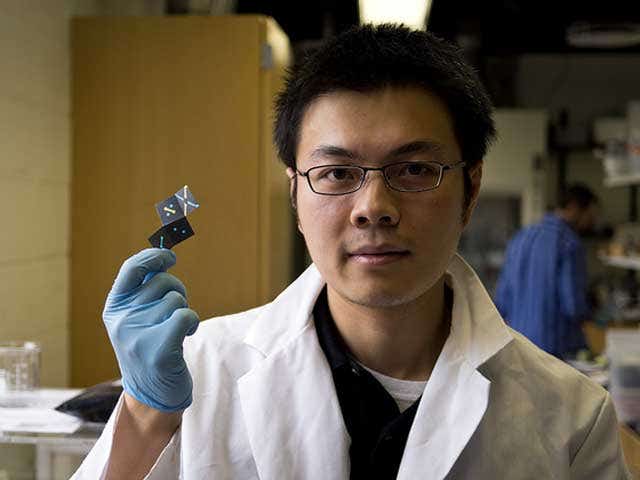Origami paper sensors could help early detection of infectious diseases
Low-cost origami paper sensors detect diseases in wastewater using mobile phones, making rapid, accessible health tracking possible.

This inexpensive and rapid testing method could significantly transform how public health initiatives are planned and managed in any future pandemics. (CREDIT: Cranfield University)
Researchers from Cranfield University have pioneered an innovative way to identify disease markers in wastewater by using origami-style paper sensors. This approach enables the detection of infectious diseases by simply using a mobile phone camera.
This inexpensive and rapid testing method could significantly transform how public health initiatives are planned and managed in any future pandemics.
Wastewater as an Indicator for Disease
Tracking infections through wastewater testing has become one of the main methods to assess disease prevalence across populations. By collecting wastewater samples from treatment plants, researchers can determine which regions have high infection rates. This approach proved instrumental during the COVID-19 pandemic to monitor community-level spread and guide health policy decisions.
The development of this new test is led by Professor Zhugen Yang, a Biosensing and Environmental Health expert at Cranfield University.
His team designed a paper-based testing platform that builds on his earlier work from 2020, which was used to detect SARS-CoV-2, Influenza A, and Influenza B in wastewater. The initial research involved using simple tools like UV lights or mobile phone cameras, making the test easy and accessible.
Limitations of Traditional Testing
Previously, the most reliable methods for wastewater testing, such as the polymerase chain reaction (PCR) test, required advanced infrastructure. PCR tests must be conducted in centralized labs by skilled personnel, which involves a complex process of sample collection, cold chain transport, and lab analysis. This traditional procedure often takes several days, making it expensive and inefficient for rapid response.
The new test developed by Professor Yang offers a faster and more cost-effective solution.
Introducing the ‘Origami’ Paper Test
The origami-inspired paper test is straightforward, portable, and fast. The process involves placing wastewater samples on a wax-printed paper sheet, which is then folded in an origami style. The paper is treated with chemicals that respond to specific disease biomarkers by changing color. These color changes, often fluorescent, can then be read using a mobile phone camera, quickly providing data that researchers can use.
Professor Yang’s innovation was also part of the national COVID-19 wastewater surveillance program. During 2021, at the height of the pandemic, Yang conducted field tests at four quarantine hotels near Heathrow Airport using this new testing device.
Unlike the PCR test, which can take up to four hours, this paper-based method provided results in less than 90 minutes. Tests were conducted in a hotel basement with minimal equipment, yet they proved to be at least as accurate as traditional PCR testing.
This innovative sensor offers several advantages, particularly in regions with limited resources. The test costs just £1, making it highly affordable. Moreover, it only requires a mobile phone camera to analyze the results, bypassing the need for costly lab infrastructure and highly trained personnel.
Yang’s research demonstrated how effective this fast sewage analysis could be in detecting infectious diseases, making it a useful tool for managing public health.
The Impact on Public Health
Professor Yang emphasized the significance of this invention, noting: "During COVID-19 we proved that fast community sewage analysis is a really effective way to track infectious diseases and help manage public health.
The simple test we have developed costs just £1 and uses the commonly available camera function in a mobile phone, making it readily accessible. This could be a real game-changer when it comes to predicting disease rates and improving public health in the face of future pandemics."
The contribution of this paper-based wastewater test has also been recognized at the London Science Museum, where it was featured for its role in the National Wastewater Surveillance Programme during the pandemic.
Future Applications and Research
The ongoing development of this device is funded by the Leverhulme Trust Research Leadership Scheme and the Biotechnology and Biological Sciences Research Council.
In the future, this testing method could be extended to monitor the spread of new disease variants or assess the prevalence of antimicrobial resistance in communities. Its ability to provide early warning signals for infections can help public health officials intervene faster and more effectively.
The development of a low-cost, efficient testing device that uses simple tools is a leap forward for public health. During the COVID-19 pandemic, rapid and accessible testing was crucial for timely responses to rising infection rates.
As the world moves towards preparing for possible future pandemics, innovations like Professor Yang’s wastewater origami test can provide an essential layer of surveillance, helping manage outbreaks in real time. This test not only offers a glimpse of a more prepared future, but also demonstrates how creative approaches can solve complex public health challenges.
Note: Materials provided above by The Brighter Side of News. Content may be edited for style and length.
Like these kind of feel good stories? Get The Brighter Side of News' newsletter.
Joshua Shavit
Science & Technology Writer | AI and Robotics Reporter
Joshua Shavit is a Los Angeles-based science and technology writer with a passion for exploring the breakthroughs shaping the future. As a contributor to The Brighter Side of News, he focuses on positive and transformative advancements in AI, technology, physics, engineering, robotics and space science. Joshua is currently working towards a Bachelor of Science in Business Administration at the University of California, Berkeley. He combines his academic background with a talent for storytelling, making complex scientific discoveries engaging and accessible. His work highlights the innovators behind the ideas, bringing readers closer to the people driving progress.



